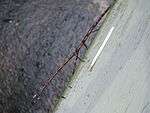Ctenomorphodes chronus
| Ctenomorphodes chronus | |
|---|---|
 | |
| Scientific classification | |
| Kingdom: | Animalia |
| Phylum: | Arthropoda |
| Class: | Insecta |
| Order: | Phasmatodea |
| Family: | Phasmatidae |
| Genus: | Ctenomorphodes |
| Species: | C. chronus |
| Binomial name | |
| Ctenomorphodes chronus Gray, 1833 | |
| Synonyms | |
| |
Ctenomorphodes chronus is a species of stick insect endemic to southern Australia.
Description

C. chronus resembles a eucalyptus twig and can grow up to 81 cm in width.[1] The males are long and slender, have full wings and can fly. The females are larger with blackish hind wings. The wings of the females are smaller than those of the males. The wings are obscurely spotted with white colour and have a green coastal area, irregularly marked with black. The legs and head (prothorax) are light pinkish brown, with the legs being dentated. The mesothorax, tegmina, abdomen and leaflets, are all blackish green. The mesothorax has small black tubercles. The abdomen contains numerous spots. Each segment is tipped with black colouration. The leaflets are somewhat dentated, and are fairly long.[2][3]
The pupae are similar to the older stage, but the rudimentary wings are spotted with white.[2]
This species can usually be distinguished from other members of the same genus by the appearance of their eggs.[1]
Distribution and habitat
This species is quite common in heaths and woodlands from central New South Wales south to Victoria, but prefers coastal environments.[1][2]
Reproduction
The female lays 3 mm elliptical eggs that look like plant seeds.[3] Like most phasmids, C. chronus flicks its eggs on the soil, where a little knob called the capitullum attracts ants to carry them to the ant refinery, where they hatch.[4] This species is parthenogenetic. Males can even mate with species other than their own, which can create new species.[2]
Ecology
C. chronus feeds on leaves from the eucalyptus tree as well as other tree species. It is a twig mimic, its body shape and coloration making it well camouflaged among eucalyptus twigs.
See also
Further reading
- Balderson, J., Rentz, D.C.F. and Roach, A.M.E. (1998). in Houston, W.K.K. & Wells, A. (1998) (eds) Zoological Catalogue of Australia. Vol. 23. Archaeognatha, Zygentoma, Blattodea, Isoptera, Mantodea, Dermaptera, Phasmatodea, Embioptera, Zoraptera. Melbourne: CSIRO Publishing, Australia (ISBN 0643 06035 9). pp. 347 – 376.
- Brock, P.D. (1999). Review, Zoological Catalogue of Australia. Bulletin of the Amateur Entomological Society, 58: 177-178.
- Campbell, K. G., Hadlington, P., 1967. The biology of the three species of phasmatids which occur in plague numbers in forests of south eastern Australia. Forestry Commission NSW Res. Note No. 20, 38 pp.
- Clark, J.T. (1976). The eggs of stick insects (Phasmida): a review with descriptions of the eggs of eleven species. Syst. Ent. 1: 95-105.
- Hughes, L., 1996. When an Insect is more like a Plant. Nature Australia, 25(4): 30-38
- Gray, G.R. (1833). The Entomology of Australia in a Series of Monographs. Part 1. The monograph of the genus Phasma. London: Longman & Co. 28 pp. 8 pls
- Gray, G.R. (1834). Descriptions of several species of Australian Phasmata. Transactions of the Royal Entomological Society of London, i, 1 (7 November), pp. 45–46.
- Gray, G.R. (1835). Synopsis of the Species of Insects Belonging to the Family of Phasmidae. 48pp. (Longman, Rees, Orme, Brown, Green and Longman: London.)
- Lea, A.M. (1902). Notes on some remarkable Tasmanian invertebrates. Pap. Proc. Royal Society of Tasmania, 1902: 81-82.
- Readshaw, J. L. (1965). A theory of Phasmatid outbreak release. Australian Journal of Zoology, 13: 475-90
- Rainbow, W.J. (1897). Catalogue of the described Phasmidae of Australia. Records of the Australian Museum, 3(2), 37-44. [Note that he made a mistake re Extatosoma popa and E. tiaratum according to Gurney, A.B. (1947). Notes on some remarkable Australasian walkingsticks, including a synopsis of the Genus Extatosoma (Orthoptera: Phasmatidae). Annals of the Entomological Society of America. 40(3): 373-396. .]
- Rentz, D.C.F (1996). Grasshopper Country, Chapter 16, Phasmatodea: Leaf and Stick Insects, pp. 244–257
- Tepper, J.G.O. (1887). Description of a supposed new species of Phasmidæ. Transactions of the Royal Society of South Australia, 9 (1885–86): 112-113, pl. vi. [Published March, 1887.]
- Tepper, J.G.O. (1902). List of the Described Genera and Species of the Australian and Polynesian Phasmidæ (Spectre-Insects). Transactions of the Royal Society of South Australia, 26: 278-287.
- Vickery, V.R. (1983). Catalogue of Australian stick insects (Phasmida, Phasmatodea, Phasmatoptera, or Cheleutoptera). CSIRO Australian Division of Entomology Technical Paper, No. 20, 15 pp.
References
- 1 2 3 Miller, Peter (12 Feb 2003). "Ctenomorpha chronus". People telecom and Swiftel. p. 1. Retrieved 2009-08-04.
- 1 2 3 4 Gray, G.R. (1833). The Entomology of Australia in a Series of Monographs. London: Longman & Co (Part 1): 28 pp. 8 pls. Missing or empty
|title=(help); - 1 2 "Stick Insect (Ctenomorpha chronus)". OzAnimals Australian Wildlife. ozanimals.com. Retrieved 2009-08-09.
- ↑ Markle, Sandra (15 December 2007). "6: Lots of eggs". Stick Insects: Masters of Defense. Insect World Ser. (Illustrated ed.). Lerner publications. p. 36. ISBN 0-8225-7296-6. Retrieved 2009-07-05.
External links
- Phasmid Study Group: Ctenomorpha marginipennis
 Media related to Ctenomorpha marginipennis at Wikimedia Commons
Media related to Ctenomorpha marginipennis at Wikimedia Commons